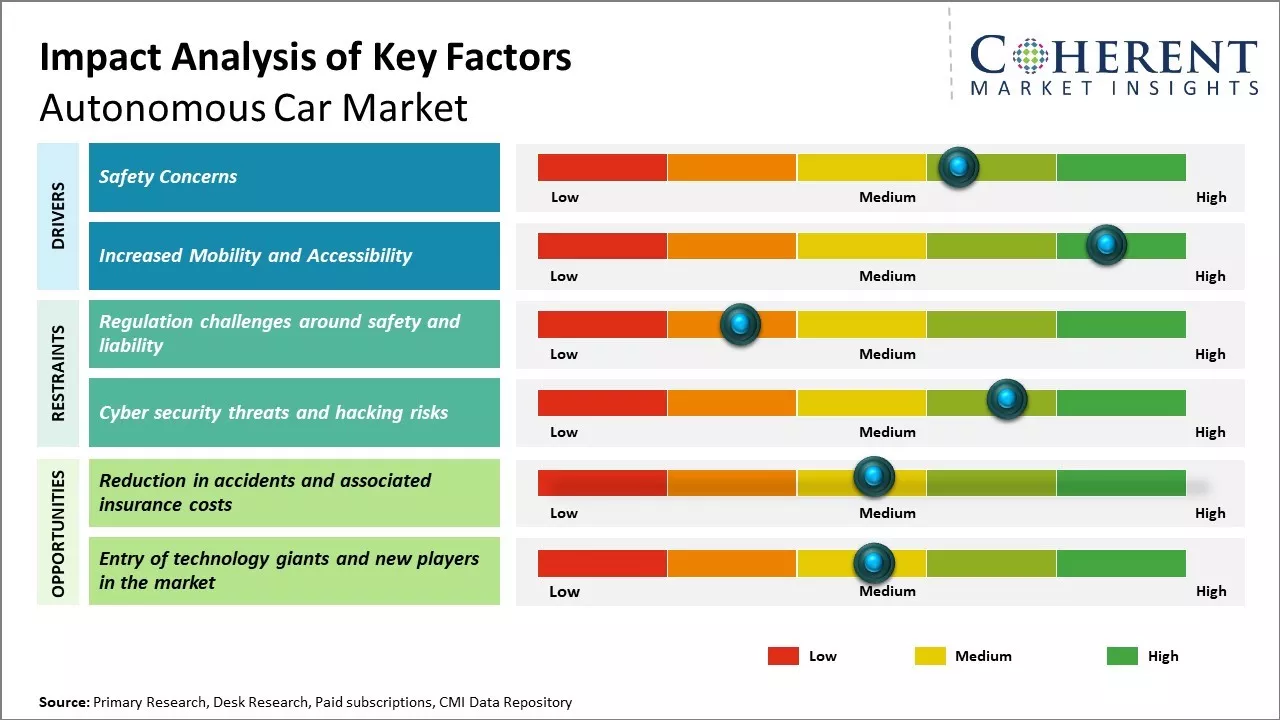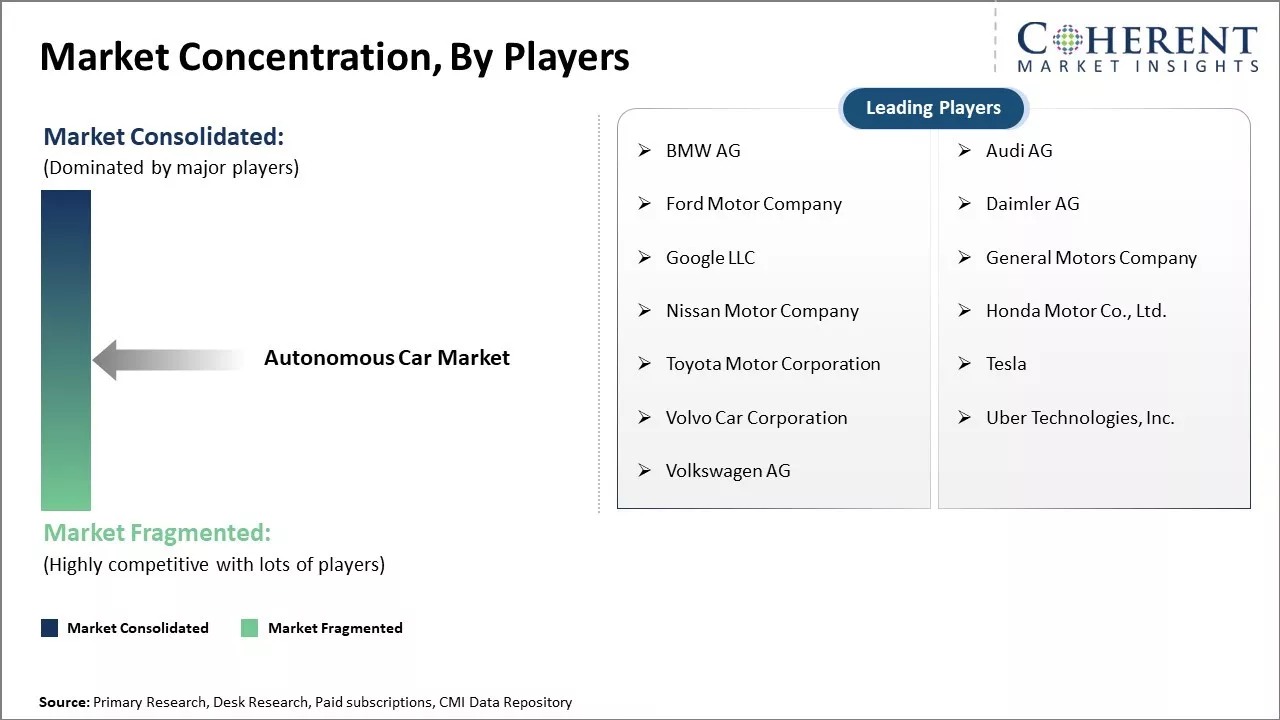The autonomous car market is estimated to be valued at USD 205.98 Bn in 2025 and is expected to reach USD 2,205.13 Bn by 2032, exhibiting a compound annual growth rate (CAGR) of 40.3% from 2025 to 2032.

To learn more about this report, Download Free Sample
Major automakers and tech companies have significantly ramped up their investments in development of self-driving technologies. Ride-hailing companies are also working towards launching autonomous ride-sharing services, and this will boost the adoption of autonomous vehicles which is responsible for the growth of the market.
However, high product and technology costs continue to remain a challenge along with other concerns around safety and regulatory issues.

To learn more about this report, Download Free Sample
|
Current Events |
Description and its impact |
|
Geopolitical Developments |
|
|
Economic and Supply Chain Dynamics |
|
Uncover macros and micros vetted on 75+ parameters: Get instant access to report
The growing emphasis on road safety and the urgent need to reduce traffic accidents are key factors driving the global adoption and development of autonomous vehicles. These vehicles, equipped with advanced sensors, AI-powered decision-making systems, and real-time analytics, have the potential to significantly reduce human error by improving situational awareness and enabling faster, more accurate responses to dynamic road conditions.
For instance, according to a World Economic Forum study published in March 2025, roads remain among the most dangerous types of infrastructure, with approximately 1.19 million people losing their lives in road traffic accidents each year.
Within the application segment of the autonomous car market, the transportation segment is expected to account for the largest share of 84.1% in 2025, due to the convenience and safety autonomous features it provides.
As traffic congestion continues to worsen in many urban areas around the world, autonomous vehicles offer a solution that saves commuters time and reduces stress. Being able to work, rest, or be entertained while the car drives itself makes long commute times more productive. Autonomous transportation also appeals to those who do not drive or are unable to, such as the elderly, disabled, or young people.
Within the level of automation segment, Level 3 has been widely adopted because it offers a good balance between functionality and safety features and is estimated to be the leading segment with 47.8% market share in 2025.
Level 3 systems can drive autonomously under limited conditions but still require a human driver to be responsive to take control if needed. This hybrid approach appeals to both automakers and consumers as it incrementally increases autonomous ability while maintaining human oversight for assurance. Level 3 vehicles use advanced driver assistance features for highway driving, but Autonomous driving system still require human monitoring and keep the steering wheel for handling complex situations.
Artificial Intelligence (AI) is revolutionizing the autonomous car market, driving innovation from foundational design to real-world application and consumer experience. As AI technologies mature, they are increasingly integrated into autonomous vehicles (AVs), enhancing safety, efficiency, and intelligence on the road.

To learn more about this report, Download Free Sample
North America is expected to lead the global autonomous car market in 2025, capturing a dominant 37.0% market share. The U.S. remains the key contributor, driven by substantial investments from major technology and automotive companies such as Google, Tesla, General Motors, and Ford in the research and development of self-driving technologies. Additionally, favorable government policies and regulatory support have enabled on-road testing in multiple states, accelerating innovation and deployment.
The Asia Pacific region is the fastest growing region owing to several critical factors deeply rooted in the region’s economic, infrastructural, technological, and policy frameworks. China, Japan, and South Korea have emerged as pioneering markets driving the dominance of APAC in this segment. This can be largely attributed to the significant investments made by both governmental bodies and private enterprises in autonomous vehicle (AV) technologies and supportive regulatory ecosystems.
As of October 2024, Wuhan featured over 400 fully driverless vehicles operating as part of a robotaxi service, covering more than 3,000 square kilometers of the city. Notably, some areas of Wuhan even offer 24-hour testing and demonstration services—highlighting the country's aggressive push toward real-world deployment.
The U.S. remains at the forefront of the global autonomous car market, driven by robust innovation, strong venture capital backing, and leadership from tech giants like Google (via Waymo), Tesla, and traditional automakers such as Ford and General Motors. In addition, the U.S. has a mature ecosystem of AI development, advanced sensor technology, and mobility services.
Germany, Europe’s automotive powerhouse, plays a central role in the development of autonomous driving technology. Home to legacy automakers such as BMW, Mercedes-Benz, and Volkswagen, the country has invested heavily in research and development, as well as in collaborations with technology firms, to accelerate innovation in autonomous vehicles. The German government has also enacted legislation permitting Level 4 autonomous vehicles on public roads under specific conditions—making Germany the first country in the European Union to do so.
According to an analysis conducted by Mobility as a Service Operation by Volkswagen Group (MOIA) in July 2025, approximately 300 million trips are taken each day in Germany. In the simulation, 12 million of these trips were allocated to an autonomous ride-pooling service, representing a four percent modal share. These trips could be serviced by 300,000 autonomous vehicles, each averaging 1.7 passengers and a wait time of just 10 minutes—spanning both rural and urban areas.
Japan is another key player in the autonomous vehicle market, leveraging its strong automotive industry and technological sophistication. Companies like Toyota, Nissan, and Honda are at the forefront of AV development, often integrating robotics, AI, and mobility-as-a-service concepts. The Japanese government has been actively preparing cities and roadways for autonomous transit ahead of major global events, including the Osaka Expo 2025.
|
Category |
Price Range |
|
Luxury Sedans & SUVs |
USD 70,000 – USD 200,000+ |
|
Mid-range Passenger Cars |
USD 40,000 – USD 70,000 |
|
Economy Vehicles |
USD 20,000 – USD 40,000 |
Uncover macros and micros vetted on 75+ parameters: Get instant access to report
| Report Coverage | Details | ||
|---|---|---|---|
| Base Year: | 2024 | Market Size in 2025: | USD 205.98 Bn |
| Historical Data for: | 2020 To 2024 | Forecast Period: | 2025 To 2032 |
| Forecast Period 2025 to 2032 CAGR: | 40.3% | 2032 Value Projection: | USD 2,205.13 Bn |
| Geographies covered: |
|
||
| Segments covered: |
|
||
| Companies covered: |
BMW AG, Audi AG, Ford Motor Company, Daimler AG, Google LLC, General Motors Company, Nissan Motor Company, Honda Motor Co., Ltd., Toyota Motor Corporation, Tesla, Volvo Car Corporation, Uber Technologies, Inc., and Volkswagen AG |
||
| Growth Drivers: |
|
||
| Restraints & Challenges: |
|
||
Uncover macros and micros vetted on 75+ parameters: Get instant access to report
*Definition: The autonomous car market involves the development and sales of self-driving vehicles that can provide transportation without human involvement. Major players in this emerging market are developing advanced sensors and robotics to enable vehicles to navigate roads and make decisions without any human input. As the technology progresses to higher levels of autonomy over the next decade, the market for fully autonomous vehicles without steering wheels or pedals is expected to grow substantially and potentially transform personal transportation.
Share
Share
About Author
Ameya Thakkar is a seasoned management consultant with 9+ years of experience optimizing operations and driving growth for companies in the automotive and transportation sector. As a senior consultant at CMI, Ameya has led strategic initiatives that have delivered over $50M in cost savings and revenue gains for clients. Ameya specializes in supply chain optimization, process re-engineering, and identification of deep revenue pockets. He has deep expertise in the automotive industry, having worked with major OEMs and suppliers on complex challenges such as supplier analysis, demand analysis, competitive analysis, and Industry 4.0 implementation.
Missing comfort of reading report in your local language? Find your preferred language :
Transform your Strategy with Exclusive Trending Reports :
Frequently Asked Questions
Joining thousands of companies around the world committed to making the Excellent Business Solutions.
View All Our Clients